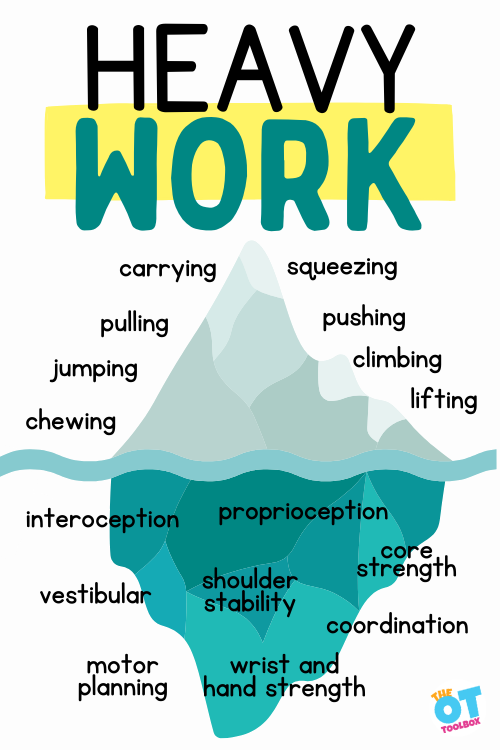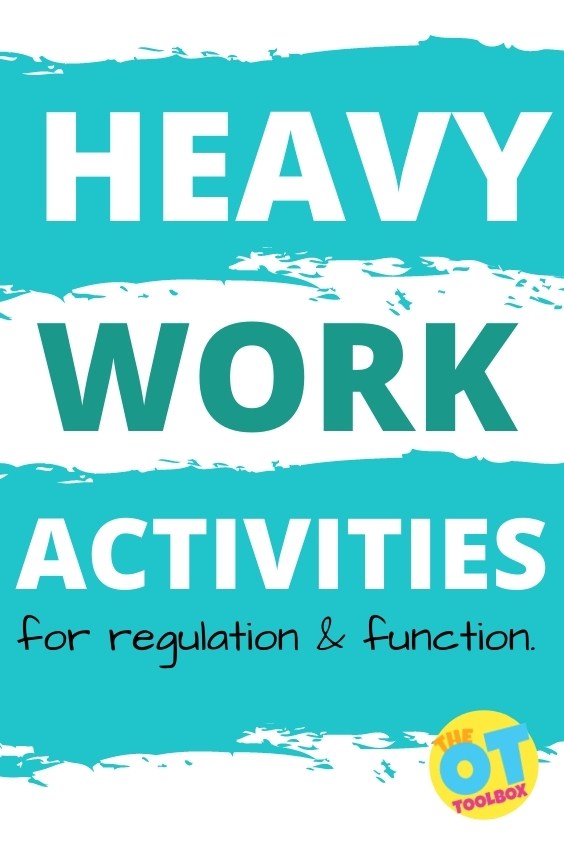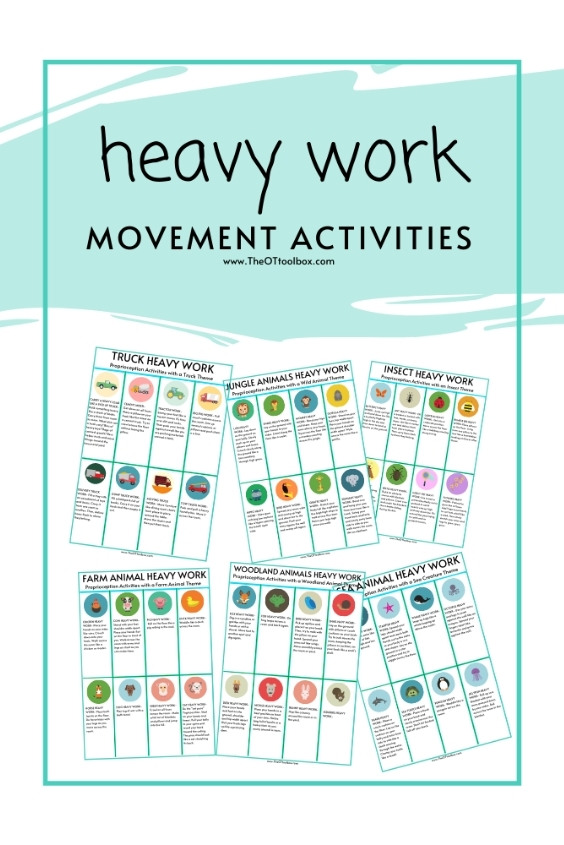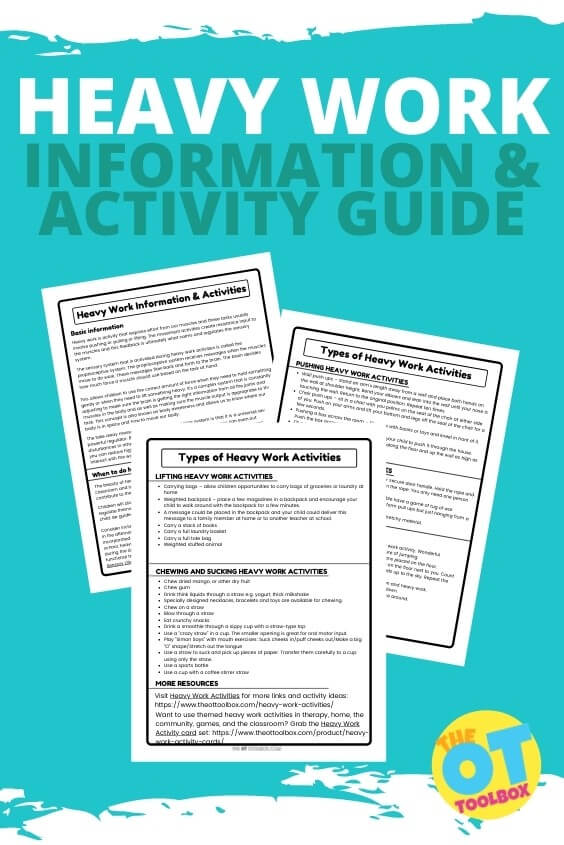Did you know the important role that heavy work activities play in our ability to learn, focus, attend, and participate in everyday tasks? It’s true. We all need calming and organizing sensory input in the form of heavy work tasks that provide proprioceptive input through the muscles and joints. Here, we’ll cover what heavy work is, when heavy work is needed, and specific heavy work strategies that kids of all ages can do at home, in the classroom, or in their therapy session.
Heavy work is a powerful support for organizing input in self-regulation. The heavy work resources here can be added to your self regulation strategies.

Heavy Work Activities
In a different world children would be ready to learn at all times. In an alternate universe children would not have temper tantrums or meltdowns in shopping centers. In another time and place all of us would be well-regulated all day and all night!
But that’s not how things work and anyone spending time with children will know that there are moments when they are out-of-sync and not quite with the program.
We all experience dysregulation at one point or another! We cover more on this in our recent blog on on the Alert program, which also has ideas for heavy work input.
And that’s all part of their journey of growing, developing and learning. You will be happy to know that when you are faced with these rather challenging times there is a powerful tool you can use to help children become more regulated…heavy work!

You can rely on heavy work to help you out to organize a dysregulated nervous system.
WHAT is HEAVY WORK?
Heavy work is activity that requires effort from our muscles and these tasks usually involve activation of the muscles and joints of the body through the proprioceptive system by movements such as pushing, pulling or lifting. The movement activities create resistance input to the muscles and this feedback is ultimately what calms and regulates the sensory system.
The sensory system that is activated during heavy work activities is called the proprioceptive system. The proprioceptive system receives messages when the muscles move to do work. These messages flow back and forth to the brain. The brain decides how much force a muscle should use based on the task at hand.
This allows children to use the correct amount of force when they need to hold something gently or when they need to lift something heavy.
It’s a complex system that is constantly adjusting to make sure the brain is getting the right information from all the joints and muscles in the body and as well as making sure the muscle output is appropriate to the task. This concept is also known as body awareness and allows us to know where our body is in space and how to move our body.
The take away message about the proprioceptive system is that it is a universal and powerful regulator.
By working with the proprioceptive system you can even out disturbances in other sensory systems. You can increase energy levels if you need to and you can reduce high energy levels to help children reach a calm, comfortable space to interact with the world.
WHEN TO DO HEAVY WORK
The beauty of heavy work is that they are really easy to incorporate at home, in the classroom and in therapy settings. Adding heavy work to a child’s daily routine will contribute to the development of their sensory processing.
Children will also gain valuable tools that they can use when the feel that they need to regulate themselves. How often you use heavy work input will depend on the individual child. Be guided by the child’s enjoyment and response to the activity that you introduce.
Consider including a heavy work activity in the morning before going to school and again in the afternoon when children arrive home from school. Heavy work can also be incorporated into bedtime routines to help the sensory system feel calm and restful.
At school, heavy sensory input for the whole class can be incorporated at regular intervals during the day. Incorporating heavy work (and other sensory system input) into daily functional tasks, or setting up a sensory lifestyle, are all concepts covered in the book The Sensory Lifestyle Handbook.
Here is more information on proprioception, or heavy work and it’s impact on attention and learning.
Why Heavy Work?
If you look at the iceberg image above, you’ll notice that the image depicts an iceberg with activity words above the water level. These tasks depict the heavy work actions that we see in action.
Heavy work may include:
- Pushing
- Pulling
- Lifting
- Carrying
- Chewing
- Jumping
- Carrying
- Squeezing
- Climbing
- Pinching
- Brushing
- Any other actions that use the muscles and joints with weight of the body or object
Under the water level, you’ll notice words and phrases that depict underlying skills. These are the components of heavy work that you might not “see” in action, but they are occurring with and through heavy work.
These are skills that we need for everyday tasks. Heavy work involves these components, and are what makes body awareness and movement happen. These are the skills that contribute to the organizing and regulating capacity of heavy work. The potential of these underlying components to contribute to the effectiveness of heavy work activities.
These underlying components include:
- Proprioception
- Interoception
- Core strength
- Coordination
- Motor planning
- Body awareness
- Vestibular input
- Core strength and stability of the shoulder girdle
- Proximal joint strength and stability (elbow, wrist, etc.)
We like to say that it’s like the chicken and the egg saying. The underlying and contributing factors of heavy work contribute to the heavy work actions and the heavy work actions contribute to the underlying contributing factors.
How to use heavy work activities
Now you are ready to use heavy work sensory input to create happy, well regulated children!
Specific children may be given opportunities to engage in additional heavy
work activities during the day if they are struggling with sensory processing and attention the classroom.
Some deep pressure work activities require no equipment and very little space. Others may require some props and a bit of space. Select your heavy work activity according to the space and items available to you.
And have a few options available. Each child has a different sensory make up and preference and will respond differently to the heavy work input that you introduce. You will soon discover the activities that they enjoy and the activities that help them to feel calmer and more regulated.
Pushing Heavy Work Activities
Pushing or pulling heavy objects, like a wagon, a weighted sled, or a suitcase, engages the muscles and joints of the proximal leg joints and the large muscle groups of the legs. These activities also engage the proximal joints and shoulder girdle of the upper extremity, as well as core strength and stability.
- Wall push ups- stand an arm’s length away from a wall and place both hands on the wall at shoulder height. Bend your elbows and lean into the wall until your nose is touching the wall. Return to the original position. Repeat ten times.
- Chair push ups- sit in a chair with you palms on the seat of the chair at either side of you. Push on your arms and lift your bottom and legs off the seat of the chair for a few seconds.
- Pushing a box across the room- fill a box with books or toys and kneel in front of it. Push the box across the room.
- Fill a laundry basket with laundry and ask your child to push it through the house.
- Push a large therapy ball or medicine ball along the floor and up the wall as high as you can go
- Push a wheelbarrow or trolley
- Wheelbarrow walking
- Pulling a wagon or sled
- Pushing someone on a swing
- Pushing off a wall or object while on a sensory swing
Pulling Heavy Work activities
Closely related to pushing, pulling heavy work uses the upper and lower extremities and the core.
- Pulling on a rope- tie a rope to a tree, pole or secure door handle. Hold the rope and see how far you can lean back while pulling on the rope. You only need one person for this tug-of-war game!
- Tug of war- if two or more children are available have a game of tug of war
- Pull up bar- it may be tricky for children to perform pull ups but just hanging from a bar is great work for muscles.
- Pulling and stretching a piece of theraband or stretchy material.
- Wall push-Ups- Have children perform wall push-ups by pushing against a wall with their hands. This provides resistance and helps build upper body strength.
- Chair push-ups- Seated push ups from the seat of a chair. This is a nice sensory strategy for the classroom.
Jumping heavy work Activities
Jumping activities add heavy work through the hips, knees, and feet.
- Trampoline- this provides endless hours of heavy work activity. Wonderful proprioceptive input while children enjoy the pleasure of jumping.
- Jumping on a mattress on the floor or couch cushions placed on the floor.
- Rocket jumps- crouch down and place your hands on the floor next to you. Count down from ten and leap into the air raising both hands up to the sky. Repeat the rocket launch a few times.
- Star jumps / jumping jacks are great for co-ordination and heavy work.
- Sitting on a small therapy ball and bouncing up and down.
- Hopper balls with handles are also a fun way to bounce around.
Lifting heavy work strategies
Lifting weighted items or carrying heavy objects such as books, backpacks, or baskets of laundry offer heavy work. In addition to holding weighted items, lifting can involve the body weight as well.
- Carrying bags- allow children opportunities to carry bags of groceries or laundry at home
- Weighted backpack- place a few magazines in a backpack and encourage your child to walk around with the backpack for a few minutes.
- A message could be placed in the backpack and your child could deliver this message to a family member at home or to another teacher at school.
- Carry a stack of books
- Carry a full laundry basket
- Carry a full tote bag
- Weighted stuffed animal
- Leg lifts, raising arms over head, holding a bridge position
- Yoga positions use lifting strategies as well
Chewing and Sucking heavy work input
Oral motor exercises and input through the mouth and face offer heavy work through the jaw, cheeks, tongue, and neck. These can be very organizing and regulating strategies.
- Chew gum, dried mango, or other dry fruit
- Drink think liquids through a straw e.g. yogurt, thick milkshake
- Specially designed necklaces, bracelets and toys are available for chewing.
- Chew on a straw
- Blow through a straw
- Eat crunchy snacks
- Drink a smoothie through a sippy cup with a straw-type top
- Use a “crazy straw” in a cup. The smaller opening is great for oral motor input.
- Play “Simon Says” with mouth exercises: Suck cheeks in/puff cheeks out/Make a big “O” shape/Stretch out the tongue. Use these printable Simon Says commands to target oral motor skills.
- Chew gum
- Use a straw to suck and pick up pieces of paper. Transfer them carefully to a cup using only the straw.
- Drinking through a sports water bottle
Try this resource for more information on heavy work through the mouth.
More Heavy Work Tools
Animal Walks
Activities like bear walks, crab walks, or crawling like a snake can engage the muscles and joints while being fun for kids.
Climbing Activities
Encourage climbing on playground equipment, climbing walls, or indoor climbing gyms. Other ideas include using playground equipment for sensory input, or climbing up a slide, when safe and appropriate.
Climbing provides heavy work for the upper body and core muscles.
Squeezing Activities
Using stress balls, therapy putty, or hand squeezers can help improve hand strength and provide sensory input.
Other squeezing heavy work activities include:
Weighted Blankets or Vests-
Weighted vests and compression garments can be used during quiet times or when sleeping to provide continuous deep pressure to the body.
Another idea is using a regular blanket as a sensory burrito.
Yoga and Deep Pressure Poses-
Some yoga poses, like downward dog or child’s pose, provide deep pressure to specific body parts and can be calming for children.
You can also include partner yoga poses in small groups for added heavy work.
Digging in the Garden-
Gardening activities, such as digging holes or moving soil, engage the muscles and joints. Check out our post on sensory gardening for more information on these benefits.
Bouncing on a Therapy Ball-
Sitting or bouncing on a therapy ball engages core muscles and provides sensory input.
- For a great resource filled with heavy work activity ideas, grab this set of heavy work activity cards that offer themed brain break cards, in 11 pages of themed heavy work activity cards, with 8 activities for each theme.
- Here are free (Spring themed) heavy work cards to get you started.
- Creating an individualized sensory diet with scheduled heavy work sensory activities (and other sensory input as needed) is part of a sensory diet. Read this resource for what a sensory diet is and this resource on how to create an effective sensory diet.
- This free slide deck offers a strategy to add heavy work in teletherapy sessions with children.
- Here are construction truck themed heavy work tasks.
- Kids love these dinosaur themed heavy work activities.
- Here are outdoor heavy work activities that can be done right in the backyard.
You will quickly discover how powerful heavy work as sensory input is and how much fun the children have when they engage in these activities. In addition to heavy work, there are various other sensory based tools that you can use to assist children who may have more complex sensory needs.
Children with sensory processing difficulties benefit from sensory diet which introduces a variety of specific sensory experience that assist with regulation.
Want to use themed heavy work activities in therapy, home, the community, games, and the classroom? Grab the Heavy Work Activity card set:

Use these heavy work cards to help with building body awareness, motor planning abilities, proprioceptive input, or a movement activity as a brain break to pay attention between learning activities. Included in the pack are:
- Trucks Heavy Work Activities
- Insects Heavy Work
- Sea Animals Heavy Work Exercises
- Farm Animals Heavy Work Ideas
- Jungle Animals Heavy Work
- Woodland Animals Heavy Work Tasks
- Superheros Heavy Work Exercises
- Sports Heavy Work Activities
- Monsters Heavy Work
- Summer Heavy Work Ideas
- Butterfly Life Cycle Heavy Work
Each activity page includes 8 movement and heavy work cards in that theme.
These heavy work strategies can be added to home programs, teletherapy activity plans, or used as brain breaks during learning and play.
Click here to get your collection of Heavy Work Activity Cards.

Free Heavy Work Activities Printable
Need heavy work ideas to use on the go? Need sensory strategies to offer to a parent or caregiver? Want to print this information so you can use the printed material to educate parents, caregivers, teachers? Want a printable list of heavy work activities?
Enter your email address into the form below to grab this free printable information packet.
Contributor to The OT Toolbox: Janet Potterton is an occupational therapist working predominantly in school-based settings and I love, love, love my job. I have two children (if you don’t count my husband!), two dogs, one cat, two guinea pigs and one fish. When I am not with my family or at work I try to spend time in nature. The beach is my happy place.


